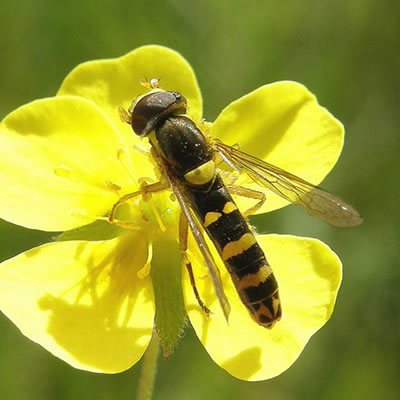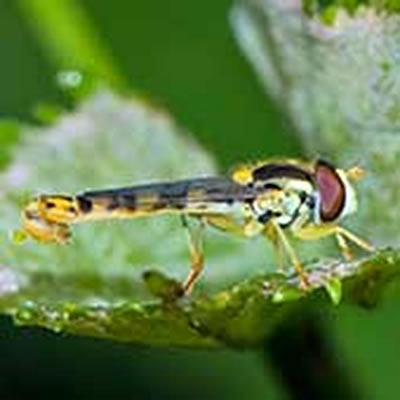Syrphid fly (Sphaerophoria philanthus)
By Kelly Rourke
Flies are among the most frequent visitors to flowers and important pollinators of a wide range of plants. Syrphid flies are often referred to as flower flies. This group exhibits a characteristic flight pattern where they hover and can abruptly change their position. As a result they are called hover flies in Great Britain. The Syrphidae family is broken down into 3 subfamilies and 15 tribes, containing more than 6,000 identified species. The total number of species may be greater, with many undescribed species found in Costa Rica.
Due to their black and yellow stripes syrphid flies can be easily mistaken for bees and wasps. The most identifiable differentiation can be seen in the wings. Flies have only one pair of wings while bees and wasps have two. Their large eyes and short antenna also give them away. The absence of pollinium, or pollen sacs, is more difficult to see, but is another difference from a bee. Of the nearly 900 species of flower flies (family Syrphidae) in North America, most have yellow and black stripes.
Largely, these are small and short bodied insects. Identification between syrphid flyspecies can be tricky as they are highly variable in appearance. Generally, Sphaerophoria spp. has one pair of iridescent wings, big eyes, a short tongue, and black and yellow stripes. Sphaerophoria philanthus has a long thin abdomen that curves slightly under at the end. The abdomen is about 3 times longer than the stout, bulbous thorax. The tergites, or back plates, on the abdomen are usually interrupted and not full stripes. They have 6 yellow legs with the hind pair much longer than the fore-pairs. Sphaerophoria philanthus are usually 7.6 to 9.6 millimeters in length.
Sphaerophoria philanthus can be found in North America from Alaska and Canada, through California, down to Mexico, and Florida. They are also abundantly found in the United Kingdom and parts of Eastern Russia. This is a widespread species occupying habitats of heathland, bogs, mire, moorland, heathy woodland rides and coastal dunes. This syrphid fly especially thrives in damper areas where purple moor-grass, cotton-grasses and rushes are present. It often visits wheat crops, grass fields, forest floors and flowers like tormentil and heath bedstraw. Sphaerophoria philanthus is also known as a key pollinator of the Stream orchid (Epipactis gigantean).



